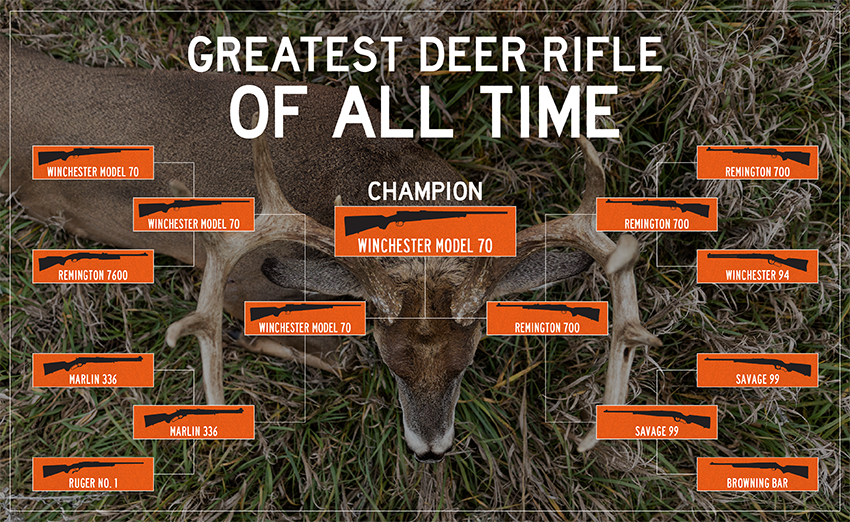The people have spoken, and by the narrowest of margins, the Winchester Model 70 has defeated the Remington 700 and been crowned the Greatest Deer Rifle of All Time.
The Model 70 was always a favorite, but its path to the championship wasn’t easy. It had to overcome the Remington 7600 in the first round and a true deer woods powerhouse, the Marlin Model 336, in the semi-final. It dominated the Remington 7600 with nearly 70% of the vote, but pulled off a far more narrow 55% to 45% victory against the Model 336.

The Model 70 was always a favorite to win this year’s October Madness contest. Known as the “Rifleman’s Rifle,” Winchester’s Model 70 has been around for nearly 90 years and sports the lines of a classic deer gun. Its roots go all the way back to the M1917 rifle of World War I, but it wasn’t designed for military use. Winchester released it as a hunting rifle in 1936 to take advantage of the growing popularity of bolt-action rifles, and it’s been a mainstay of deer camps ever since.
That popularity can be attributed to several factors. Right out of the gate, the rifle earned a reputation for excellent accuracy. That was due in part to Winchester’s high build quality and in part due to the crisp, adjustable trigger that came with every rifle. Only accurate rifles are interesting, as they say, and the Model 70 was very, very interesting to millions of hunters.
It also benefited from the endorsement of legendary hunter and gun writer Jack O’Connor, who used a Model 70 to popularize his pet cartridge, the .270 Winchester. While O’Connor most famously used his Model 70 to chase sheep, deer hunters quickly learned that what’s good for the mountains is great for the woods. Celebrity endorsements can be risky business, but O’Connor’s good reputation has outlived him. Even four decades after his death, the path is short between learning about O’Connor, loving his work, and purchasing a Model 70.
Of course, no truly popular person or product is without controversy. Winchester made design and production changes to the rifle in 1964, which were largely derided by Model 70 fans. Prior to that year, the Winchester Model 70’s bolt featured a Mauser-style, or controlled feed, action. After that, Winchester decided to cut costs and go with a push feed action, which rifle hunters claimed was more prone to malfunction. They also lamented other production changes, such as stamped checkering instead of hand checkering on the stocks, plastic in place of some metal parts, and cheaper bluing on the barrel.

While Jack O’Connor would later temper his assessment of Winchester’s revisions, his initial impression was… not good. Here’s how he described his first glimpse of the new Model 70:
“The action was simplified, the trigger guard and floor plate made of a flimsy-looking one-piece stamping. The stock had stodgy lines and no checkering, and the barrel channel was routed out so much a herd of cockroaches could hold a ball below the barrel. On my first glimpse of the ‘New Model 70’ I was surrounded by the designers and by Winchester brass. I told them the creation would not sell, that it was one of the ugliest rifles I had ever seen.”
Despite this less-than-stellar review, the Model 70 continued to sell. And sell. And sell. Winchester offers new models starting around $1,200, and used models can be had at most gun shops as well as online auction sites like GunBroker. A pre-64 Model 70 can easily go for several thousand dollars, but if you’re not too picky about production year or condition, you can walk away less than $1,000 poorer.
That popularity and the rifle’s continued production means that most deer hunters have at least one beloved Model 70 in the family. It’s no surprise, then, that when asked to select history’s greatest deer gun, the MeatEater audience went with America’s most iconic bolt-action sporting rifle.
Read the full article here

